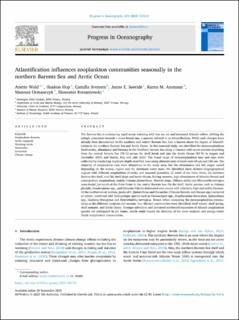| dc.description.abstract | The Barents Sea is undergoing rapid ocean warming with less sea ice and increased Atlantic inflow, shifting the pelagic ecosystem towards a more boreal one, a process referred to as Atlantification. While such changes have already been documented in the southern and central Barents Sea, less is known about the degree of Atlantification in the northern Barents Sea and Arctic Ocean. In this seasonal study, we identified the mesozooplankton biodiversity, abundance and biomass in the Northern Barents Sea along a transect with seven stations stretching from the central Barents Sea (76°N) across the shelf break and into the Arctic Ocean (82°N) in August and December 2019, and March, May and July 2021. The broad range of mesozooplankton taxa and sizes were collected by conducting duplicate depth-stratified tows using alternate nets of mesh-sizes 64 µm and 180 µm. The majority of zooplankton taxa were ubiquitous in the study area, but the abundances and life stages varied depending on the season, region and the dominant water mass. We identified three distinct biogeographical regions with different zooplankton diversity and seasonal dynamics; (i) south of the Polar Front, (ii) northern Barents Sea shelf, and (iii) shelf slope and Arctic Ocean. During summer, high abundances of Atlantic/boreal and cosmopolitan zooplankton, mainly Calanus finmarchicus, Metridia longa, Oithona similis and Microsetella norvegica were found just south of the Polar Front in the central Barents Sea. On the shelf, Arctic species, such as Calanus glacialis, Pseudocalanus spp., and Limacina helicina dominated year-round with relatively high and stable biomass. At the northernmost stations, peaks of C. finmarchicus and Oncaeidae (Triconia borealis and Oncaea spp.) occurred in winter, combined with bathypelagic species such as Paraeuchaeta spp., Scaphocalanus brevicornis, Spinocalanus spp., Gaetanus brevispinus and Heterorhabdus norvegicus. Hence, when comparing the mesozooplankton communities at the different locations and seasons, four distinct communities were identified: shelf winter, shelf spring, shelf summer, and Arctic Ocean. Stronger advection and increased northward expansion of Atlantic zooplankton species are anticipated in the future, which could impact the diversity of the more endemic and energy-richer Arctic zooplankton communities. | en_US |
